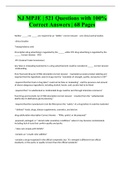-
1. Exam (elaborations) - Nebraska mpje | 176 questions with 100% correct answers
-
2. Exam (elaborations) - Ohio mpje question bank 2022 | 430 questions with 100% correct answers
-
3. Exam (elaborations) - Ohio mpje sullivan exam set |(444 questions) with complete solution
-
4. Exam (elaborations) - Ohio mpje 2022 | 931 questions and answers 100% correct
-
5. Exam (elaborations) - Ohio mpje | 470 questions with 100% correct answers
-
6. Exam (elaborations) - Multistate pharmacy jurisprudence examination (mpje) mpje ny comprehensive study guid...
-
7. Exam (elaborations) - Multistate pharmacy jurisprudence exam (mpje) review (federal law)
-
8. Exam (elaborations) - Ny mpje study set (rxpharmacist) questions with complete solutions
-
9. Exam (elaborations) - Ma mpje - 247 cmr | 350 questions with 100% correct answers
-
10. Exam (elaborations) - Ct mpje questions and answers graded a
-
11. Exam (elaborations) - Ct mpje exam questions bank | 722 questions with 100% correct answers
-
12. Exam (elaborations) - Indiana mpje | 363 questions with 100% correct answers
-
13. Exam (elaborations) - Indiana mpje practice questions and answers | (110 questions) graded a
-
14. Exam (elaborations) - Nevada mpje | 328 questions with 100% correct answers
-
15. Exam (elaborations) - New mexico mpje | 151 questions with 100% correct answers
-
16. Exam (elaborations) - Texas mpje, ultimate texas mpje 2022 | 343 questions with 100% correct answers
-
17. Exam (elaborations) - Nj mpje | 521 questions with 100% correct answers | 68 pages
-
18. Exam (elaborations) - Virginia mpje | 251 questions with 100% correct answers
-
19. Exam (elaborations) - Pharmacy law mpje exam: federal law | 249 questions with 100% correct answers
-
20. Exam (elaborations) - Mpje illinois | 359 questions with 100% correct answers
-
21. Exam (elaborations) - Federal mpje 2022 study guide | with complete solution
-
22. Exam (elaborations) - Illinois mpje practice exam questions and answers a graded
-
23. Exam (elaborations) - Federal mpje practice questions and answers| 100 questions
-
24. Exam (elaborations) - Mpje dea study guide questions and answers all correct
-
25. Exam (elaborations) - Naplex practice questions with complete solutions
-
26. Exam (elaborations) - Naplex questions with complete solutions
-
27. Exam (elaborations) - Naplex review| 219 questions| with complete solutions
-
28. Exam (elaborations) - Hiv drug naplex review questions with complete solutions
-
29. Exam (elaborations) - Oncology naplex review 2022-2024 questions with complete solutions
-
30. Exam (elaborations) - Naplex review- immunizations questions with complete solutions
-
31. Exam (elaborations) - Apha naplex review questions with complete solutions
-
32. Exam (elaborations) - Naplex review 2023 questions with complete solutions
-
33. Exam (elaborations) - Federal law review naplex questions with complete solutions
-
34. Exam (elaborations) - Naplex review- calculations and equations(with complete solutions)
-
35. Exam (elaborations) - Naplex 2023 review questions with complete solutions
-
36. Exam (elaborations) - Naplex review| 2000+ questions| with complete solutions| 451 pages
-
37. Exam (elaborations) - Naplex- top drug review- 309 questions- with complete solutions
-
38. Exam (elaborations) - Brand/generic naplex review 2022-2024 questions with complete solutions
-
39. Exam (elaborations) - Apha naplex review| 660 questions| with complete solutions
-
40. Exam (elaborations) - Study tip gal naplex review| 135 questions| with complete solutions
-
41. Exam (elaborations) - Pre naplex review| 101 questions| with complete solutions
-
42. Exam (elaborations) - Naplex review(450 questions) with complete solutions
-
43. Exam (elaborations) - Infectious disease naplex review| 222 questions| with complete solutions
-
44. Exam (elaborations) - Naplex review-754 questions-with complete solutions
-
45. Exam (elaborations) - Naplex review (abx, math, norms, ddis, etc)| 1059 questions| with complete solutions
-
46. Exam (elaborations) - Naplex review-315 questions-with complete solutions
-
47. Exam (elaborations) - Naplex review – cardiology- 301 questions- with complete solutions
-
48. Exam (elaborations) - Naplex cpje review| 200 questions| with complete solutions
-
49. Exam (elaborations) - Naplex study to review| 92 questions| with complete solutions
-
50. Exam (elaborations) - Naplex 2023 questions and answers
-
51. Exam (elaborations) - Naplex review exam| 250 questions| with complete solutions
-
52. Exam (elaborations) - Naplex practice questions with complete solutions
-
53. Exam (elaborations) - Cpje exam| 135 questions| with complete solutions
-
54. Exam (elaborations) - Cpje 2022-2024 | 290 questions| with complete solutions
-
55. Exam (elaborations) - Cpje law| 230 questions| with complete solutions
-
56. Exam (elaborations) - Top 500 drugs cpje questions with complete solutions
-
57. Exam (elaborations) - Cpje law 2023 - pharm operations and pharm practice questions with complete solutions
-
58. Exam (elaborations) - Cpje top 400 drugs training wheel ver.| 411 questions with complete solutions
-
59. Exam (elaborations) - Cpje study guide| 217 questions with complete solutions
-
60. Exam (elaborations) - Top 500 drugs naplex cpje (w/ chemotherapeutics)| 583 questions| with complete soluti...
-
61. Exam (elaborations) - Cpje clinical mnemonics| 333 questions| with complete solutions
-
62. Exam (elaborations) - Naplex/cpje brand-generics 2023-770 questions- with complete solutions
-
63. Exam (elaborations) - Pnn cpje 861 questions with complete solutions
-
64. Exam (elaborations) - Cpje practice 1, final cpje review, cpje oncology, cpje/naplex – hiv| 1973 question...
-
65. Exam (elaborations) - Cpje - brand/generic| 551 questions| with complete solutions
-
66. Exam (elaborations) - Cpje - top 400 + indication questions with complete solutions
-
67. Exam (elaborations) - Cpje 2019 brands/generics, cpje, auxiliary labels for cpje, 2019 top 300 drugs, cpje ...
-
68. Exam (elaborations) - Cpje with updated info (2019), cpje, cpje, cpje notes, cpje, california law time allo...
-
69. Exam (elaborations) - Cpje flashcard| 1213 questions| with complete solutions
-
70. Exam (elaborations) - Naplex study guide key points questions with complete solutions
-
71. Exam (elaborations) - Washington mpje| 307 questions| with complete solutions
-
Show more




